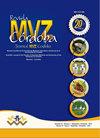牛新孢子虫血清抗体在墨西哥中部和东部地区的流行
IF 0.3
4区 农林科学
Q4 AGRICULTURE, DAIRY & ANIMAL SCIENCE
引用次数: 0
摘要
目标。确定来自墨西哥湾中部和南部地区的肉牛和两用牛中犬新孢子虫(PSA)抗体的流行率,并评估其与母牛(怀孕和未怀孕)的生殖状态(RS)的关系。材料和方法。抽取了422头牛的血液样本。抗体检测采用商用ELISA试剂盒。采用logistic回归模型分析PSA,包括州、州内乡镇和乡镇内牧场。结果。塔巴斯科州、普埃布拉州和韦拉克鲁斯州的PSA相似(p < 0.05)。这三个州的平均PSA为24.0%。各乡镇的PSA从7.8 - 43.3%不等。在普埃布拉州,San jos本文章由计算机程序翻译,如有差异,请以英文原文为准。
Prevalence of Neospora caninum bovine serum antibodies in the Central and Eastern regions of Mexico
Objective. To determine the prevalence of antibodies against Neospora caninum (PSA) in beef and dual-purpose cattle from the Central and Southern Gulf of Mexico regions, as well as to evaluate its association with the reproductive status (RS) of the cow (pregnant, not pregnant). Materials and methods. Blood samples were taken from 422 cows. Antibodies were detected with a commercial ELISA kit. PSA was analyzed with a logistic regression model that included state, township nested within state, and ranch nested within township. Results. The states of Tabasco, Puebla and Veracruz had similar PSA (p>0.05). The mean PSA for the three states was 24.0%. The PSA varied from 7.8 to 43.3% across townships. In Puebla, the PSA in cattle from San José Acateno township was more than two-fold greater than that in cattle from Hueytamalco and Nauzontla townships (p<0.05). In Tabasco, Cunduacán, Huimanguillo and Ranchería El Puente townships showed similar (p>0.05) PSA. In Veracruz, cows from Cotaxtla and Medellín de Bravo townships presented higher (p<0.05) PSA than those from San Rafael township. The RS of seropositive females was similar (p>0.05) to that of seronegative females. Conclusions. The three states had similar PSA. All the herds had antibodies against N. caninum, suggesting that this parasite is amply distributed in the three states. In addition, great variation existed among herds and among townships; finally, the presence of N. caninum antibodies was not associated with the RS of the cow.
求助全文
通过发布文献求助,成功后即可免费获取论文全文。
去求助
来源期刊

Revista Mvz Cordoba
农林科学-奶制品与动物科学
CiteScore
0.70
自引率
0.00%
发文量
41
审稿时长
6-12 weeks
期刊介绍:
The Journal MVZ Córdoba is an open access international scientific journal financed and edited by the University of Córdoba (Colombia). The journal publishes quarterly, continuously in PDF, XML, Epub, original articles, literature reviews, brief communications and clinical cases, peer-reviewed (double-blind) in Spanish and English, which are related to the agricultural and veterinary sciences. The journal is directed to natural and legal persons of veterinary medicine, animal husbandry, public health, epidemiology, aquaculture, biology, basic biomedical sciences and biotechnology and constitutes a space for academic and scientific discussion around the work of professionals in Veterinary Medicine and Zootechnics. Four-monthly publication.
"The Journal MVZ Córdoba supports the policies for registration of clinical trials of the World Health Organization (WHO) and the International Committee of Medical Journal Editors (ICMJE), since it recognizes the importance of these initiatives for international registration and dissemination. of information about clinical studies, in open access. As a result, since 2007, the journal MVZ Córdoba only publishes clinical research articles that have received an identification number in one of the Clinical Trial Registries validated by the criteria established by WHO and ICMJE, whose addresses are available in the ICMJE website. The identification number is recorded at the end of the summary. "
 求助内容:
求助内容: 应助结果提醒方式:
应助结果提醒方式:


